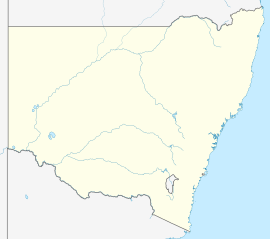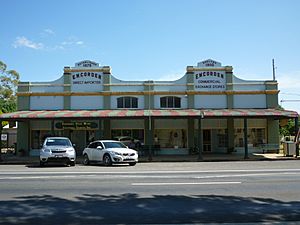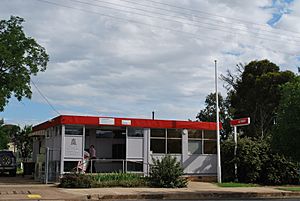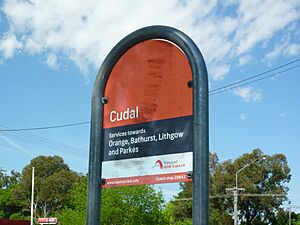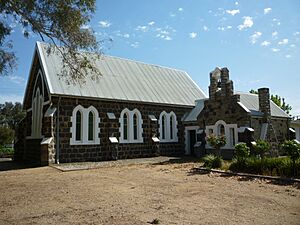Cudal, New South Wales facts for kids
Quick facts for kids CudalNew South Wales |
|
|---|---|
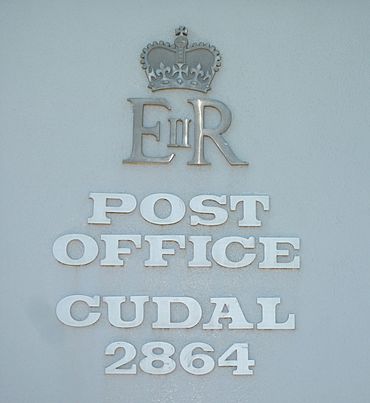
Post office
|
|
| Population | 339 (2011 census) |
| Postcode(s) | 2864 |
| Location | |
| LGA(s) | Cabonne Shire Council |
| State electorate(s) | Orange |
| Federal Division(s) | Calare |
Cudal (pronounced "KEW-dal") is a small town in the Central West area of New South Wales, Australia. It sits on the traditional lands of the Wiradjuri people. Cudal is part of the Cabonne Shire Council local government area. It is about 296 kilometres (184 miles) west of Sydney, the state capital.
The town was first mapped out in 1867. "Boree Creek" runs through Cudal. You can often spot platypuses in Boree Creek! This is why Cudal is known as the 'home of the platypus' on signs when you enter the town. The name Cudal might come from an Aboriginal word meaning 'flat'. In 2011, Cudal had a population of 339 people. The town's businesses include shops, government services, and farming, especially sheep and canola. Cudal is surrounded by rich, fertile soil from old lava flows. These flows came from Gaanha Bula Mount Canobolas, about 30 kilometres (19 miles) to the east.
Contents
History of Cudal
Major Thomas Mitchell began his journey to explore inland Australia from a historic home called Boree Cabonne, near Cudal, in 1835.
Two main things helped Cudal become a town. First, in the 1860s, new laws in New South Wales allowed people to choose land in new areas. Second, people needed a way to reach the gold fields in Forbes. This meant they had to cross Boree Creek. Cudal is located right on the banks of Boree Creek. It was a good stopping point between Orange, Canowindra, and Eugowra. Travellers could rest, care for their horses, and stay safe from bushrangers.
Cudal was first surveyed in 1867. By 1882, the town had two churches, a bank, and a public school that started in 1876. It also had five stores, three hotels, and many other businesses.
Cudal is on "The Escort Way." This was an important road in New South Wales for moving gold from the mining areas to bigger towns. Because of this, famous bushrangers like Ben Hall and Frank Gardiner were active in the area.
Many local men from Cudal served in wars for their country. The memorial park gates on Main Street honour their service. They also list those who died while serving.
A wooden bridge crossing Boree Creek was badly damaged by floods in 1959. A new concrete bridge was built to replace it.
Hazelton Airlines started flying from Cudal airport in 1959. The airport was on the flat land east of the town. Hazeltons used it as their main office and for plane repairs. They stopped flying in the 1990s. Hazeltons was a very important employer for the people living in Cudal.
On May 5, 2015, a fire destroyed the Royal Hotel on Main Street. The building was later completely taken down.
Cordern's Store: A Community Hub
The Commercial Exchange Store was built on Main Street in 1901. It replaced an older building from 1875. This store was designed to sell everything the people of Cudal and the surrounding area might need. This included clothes, food, and tools. In 1921, Mr. E. W. Cordern bought the store and changed its name to "Cordern's Store." It stayed open until 1958.
After that, the local Boree Shire Council used the building until 2001. Then, a group of local women took over. The building is now a central part of Cudal's shops again. It is called the "Cabonne Food Wine and Cultural Centre." This centre has a cafe, sells crafts and antiques, and even has a library. It also has displays about the town's history and its people. Volunteers from the community run the centre from Friday to Sunday.
Businesses in Cudal
Cudal has different types of businesses. These include a cafe, a general store, and the Cabonne Food Wine & Cultural Centre. The Australia Post Post Office also acts as a place where you can do banking for some banks, like Commonwealth Bank. It also sells newspapers and magazines. There is a Credit Union agency inside the council office.
The Bowling Club offers fun activities and has an ATM for getting cash. Shell has a petrol station that is open 24 hours a day, just off Main Street. For visitors, there is a caravan park and a motel. The town is also good for people travelling in RVs (recreational vehicles).
Cumulus Estate Wines
In the Cudal area, you'll find the Cumulus Estate Wines winery. This is where they bottle and store wines like "Rolling" (which is served on Qantas flights), "Climbing," and "Six Hundred Above." The winery can process 10,000 tonnes of grapes each year. It has places for fermenting and aging wine. It can also store 8 million litres of wine. Much of this is in a huge underground barrel hall carved into the local volcanic rock. This barrel hall is also used for special wine-tasting dinners.
Monument Vineyard
The Monument Vineyard is a large vineyard, about 250 acres, located in the Cudal district. It has special red soil called terra rosa. Inside the vineyard, there is also a large farm with about 240,000 hens that lay eggs. These hens are kept in a cage-free environment.
Education
Cudal Public School is a school for children from Kindergarten to Year 6. It serves children from the town and the surrounding area.
Transport
NSW TrainLink runs regular bus services through Cudal. These buses connect Cudal with Orange, Cootamundra (where you can catch trains to Melbourne), Forbes, and Sydney.
Churches
Cudal has three historic churches. These include the Catholic church of St. Columbanus, which was built in 1880. There is also the Church of England church of St. James. The third church was a Uniting Church, but it has now been sold to a private owner.
Famous People from Cudal
- Merle Parrish (born 1932): She is a guest on the TV show MasterChef Australia and has written cookbooks.
- Neville Sellwood (1922-1962): He was one of Australia's greatest jockeys in the 1950s and early 1960s. He was born in Brisbane and raced horses in Australia, the USA, and the UK. He rode the horses that won the Melbourne Cup in 1951 and 1955. He also won the Epsom Derby in 1962. Neville Sellwood died in France in 1962 when his horse fell. He had used some of his money to buy a sheep farm near Cudal. He is buried in the Cudal cemetery.
- Ian Stapleton (1951-2023): He was an architect who specialized in restoring old buildings and preserving history. He also wrote books. Some of his projects include the Sydney GPO (General Post Office), the Wolloomooloo finger wharf, the Bradman home in Bowral, and Blackdown homestead in Bathurst.


